Medical Disclaimer: This article is for informational purposes only and does not replace professional veterinary advice. Always consult your veterinarian if your dog is vomiting or unwell.
Table of Contents
Watching your dog vomit can be both alarming and emotionally upsetting. As a practicing veterinarian in Canada, I’ve comforted countless worried pet owners who’ve come in after seeing their dog suddenly throw up. Sometimes it’s something simple like a pup who ate too quickly or got into the trash. But other times, vomiting is the first clue that something serious is going on beneath the surface, like an infection, toxin exposure, or organ disease.
That’s why understanding dog vomiting is so important. Knowing when it’s okay to wait and watch, and when it’s time to get your vet involved, can make a huge difference in your dog’s recovery. This guide will walk you through the most common causes of vomiting, what you can safely do at home, and the red flags that mean you should seek help right away.
Whether your dog vomited just once or this is becoming a pattern, you’re in the right place to learn what steps to take next with confidence and care.
🐾 Key Takeaways: What Every Dog Owner Needs to Know
- Dog vomiting is a symptom, not a diagnosis—it can range from mild to life-threatening.
- Common causes include dietary indiscretions, infections, toxins, and chronic illnesses like pancreatitis or kidney disease.
- Mild cases can often be managed at home with fasting and a bland diet—but some symptoms require a vet visit right away.
- Look for red flags like blood in vomit, frequent episodes, or signs of pain or lethargy.
- Puppies, seniors, and dogs with chronic health issues are especially vulnerable.
- Prevent dog vomiting by feeding a consistent, high-quality diet, keeping toxic items out of reach, and reducing stress.
Why Dogs Vomit: Understanding the Basics
Also visit: https://doglifeexpert.com/5-proven-solutions-for-dog-anxiety-vet-approved/
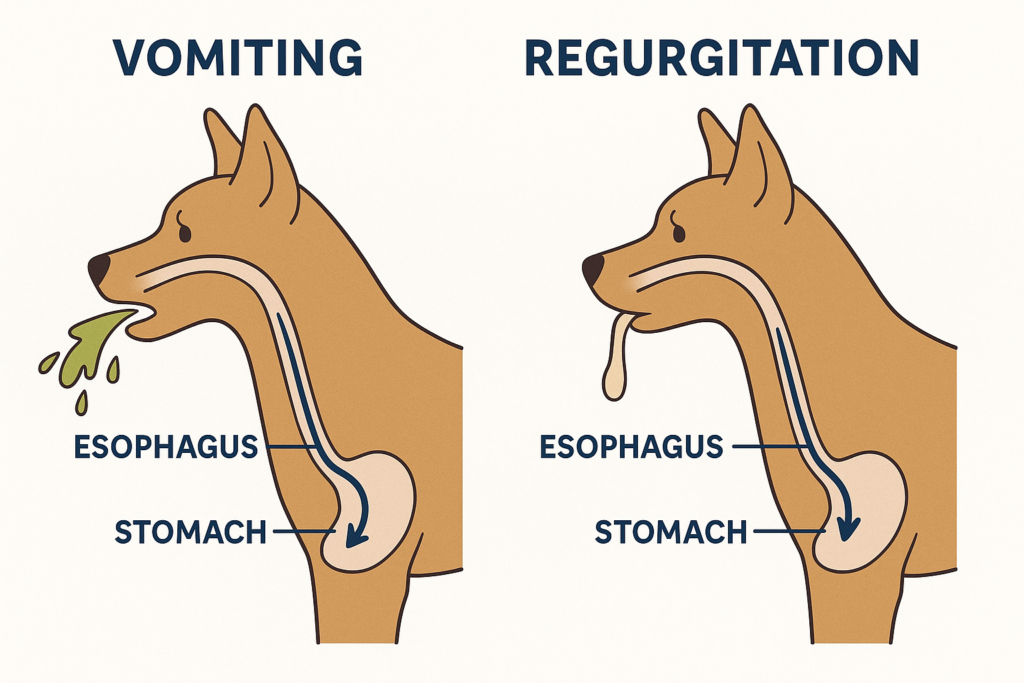
Dog vomiting is the body’s natural reflex to expel something it perceives as harmful. It’s an active process that involves noticeable abdominal contractions and retching. This differs from regurgitation, which is passive and usually occurs soon after eating, without any abdominal effort.
Occasional episodes of dog vomiting aren’t always a cause for concern especially if your dog is bright, alert, and acting normally afterward. However, frequent vomiting or a sudden onset of symptoms could be a sign of something more serious that requires veterinary care.
Understanding what’s typical for your dog can help you catch problems early. A one-time vomit with no other symptoms can often be safely monitored at home. But if your dog is vomiting repeatedly or shows other warning signs like diarrhea, lethargy, or loss of appetite, it’s time to call your vet.
In my clinic, I’ve seen many cases where pet parents waited too long, hoping things would resolve on their own. Acting early often leads to faster recovery especially in vulnerable pets like puppies and seniors.
Common Causes of Dog Vomiting
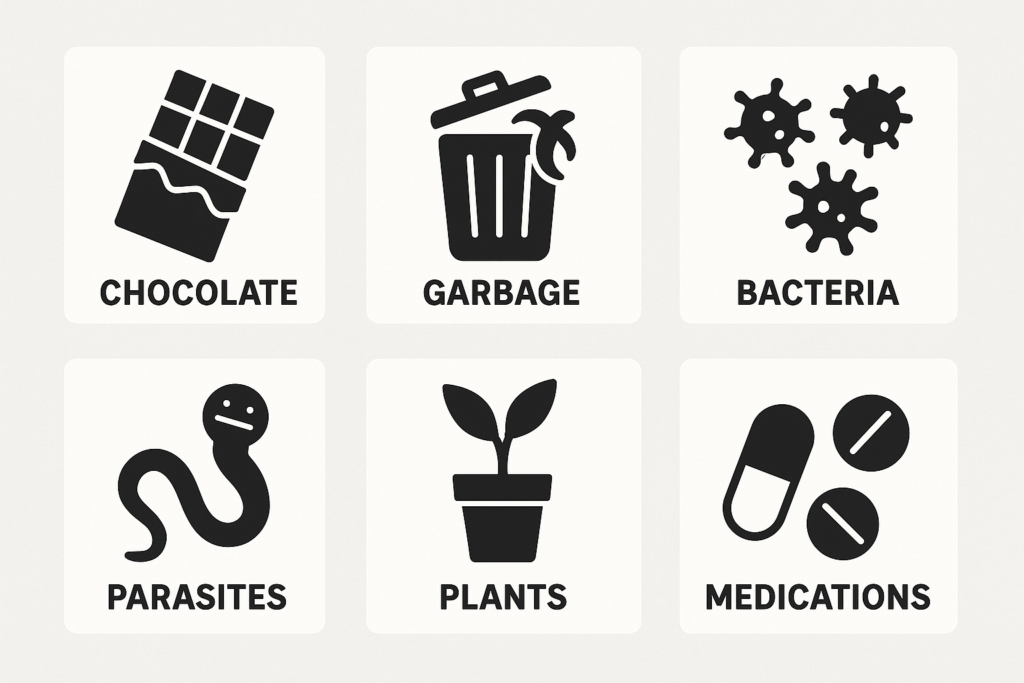
https://veterinarypartner.vin.com/default.aspx?pid=19239&id=4952122
1. Dietary Indiscretions
Most cases of dog vomiting I see in general practice are due to dogs eating something they shouldn’t.
This often includes:
- Garbage or spoiled food
- Table scraps or rich, greasy meals
- Sudden changes in diet without a transition period
- Toxic foods like chocolate, grapes, onions, or xylitol
- Foreign objects like socks, toys, or cooked bones
These incidents typically lead to a single episode of dog vomiting, but if your dog vomits more than once or shows other symptoms, contact your vet.
2. GI Irritations & Infections
Inflammation in the digestive tract is another frequent cause of dog vomiting.
This may result from:
- Gastritis: inflamed stomach lining from eating irritants
- Gastroenteritis: more widespread gut inflammation, often viral or bacterial
- Food intolerances or allergies
- Obstructions in the intestines from foreign objects or tumors
These cases of dog vomiting often come with drooling, diarrhea, or signs of abdominal pain.
3. Parasites & Pathogens
Parasites such as roundworms, hookworms, and giardia are common in puppies and shelter dogs. These can trigger dog vomiting and diarrhea due to intestinal inflammation.
Serious viral diseases like parvovirus are especially dangerous. Vomiting paired with bloody diarrhea or extreme lethargy in a puppy is always an emergency.
4. Toxins, Plants & Human Foods
Some of the most critical cases of dog vomiting I’ve seen involved accidental toxin ingestion.
These toxins include:
- Chocolate, raisins, grapes, or gum with xylitol
- Over-the-counter medications like Advil or Tylenol
- Toxic plants such as lilies or sago palms
- Slug bait, rodenticides, or antifreeze
- Household cleaning products
Even small amounts can be deadly. If you suspect poisoning, call your vet or a pet poison hotline immediately (Pet Poison Helpline).
5. Underlying Health Conditions
Chronic or recurring dog vomiting may signal a deeper medical issue:
- Pancreatitis: often triggered by rich or fatty meals
- Kidney or liver disease: reduced ability to clear toxins from the body
- Diabetes: especially when poorly managed
- Addison’s disease: causes electrolyte imbalances and digestive upset
- Cancer: more common in older dogs, can affect many organs
Watch for signs like appetite loss, bad breath, or sudden weight changes.
6. Motion Sickness & Anxiety
Stress and car sickness can also lead to dog vomiting, especially in puppies. Vomiting from stress is often situational—like after fireworks, vet visits, or travel.
If it happens frequently, your vet can suggest safe treatments to help.
How to Evaluate Vomiting at Home
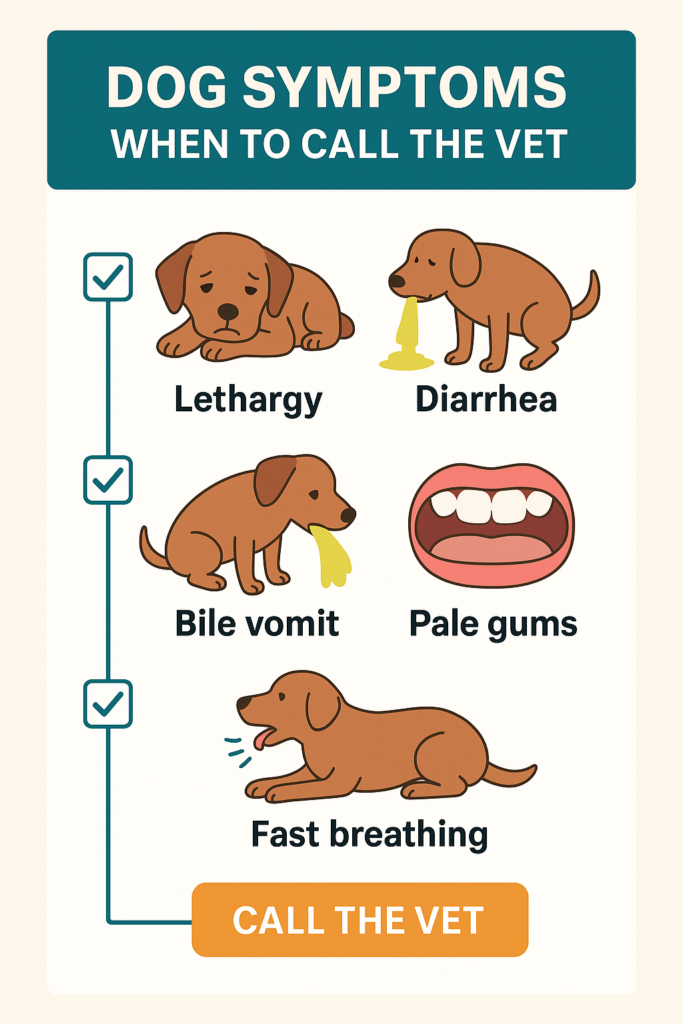
Before rushing to the vet, take a few minutes to assess what’s really going on. This helps you make a smart, calm decision.
What the Vomit Looks Like
The appearance of the vomit can offer useful clues:
| Vomit Type | What It Might Mean |
|---|---|
| Undigested food | Ate too fast or mild stomach upset |
| Yellow bile | Empty stomach (common in the morning) |
| White foam | Gastric irritation or acid buildup |
| Blood (red) | Ulcers or trauma in upper GI tract |
| Coffee-ground-like | Digested blood more serious |
| Foreign items | Toys, fabric, grass may signal obstruction |
Symptom Checklist
When your dog is vomiting, it’s important to look at the bigger picture not just the vomit itself. Certain symptoms, when seen alongside dog vomiting, can indicate that something more serious is going on.
Watch for signs like:
- Lethargy: If your dog seems unusually tired, withdrawn, or isn’t responding to you like they normally would
- Diarrhea: Especially when combined with dog vomiting, this increases the risk of dehydration
- Loss of appetite or refusal to drink: Skipping one meal might be okay, but not eating or drinking at all is a red flag
- Painful behavior: Whining, pacing, hunching their back, or guarding their belly could mean they’re in discomfort
- Fever: A rectal temperature over 39.4°C (103°F) is considered a fever in dogs
- Pale gums or rapid breathing: These could signal shock, blood loss, or other systemic problems
The more of these symptoms you notice with dog vomiting, the more urgent it is to contact your vet. Don’t wait and see acting early could save your dog’s life.
5-Minute Home Assessment Tool
Ask yourself:
- How many times has my dog vomited today?
- Are they still eating or drinking?
- Is the vomit bloody, black, or full of foreign items?
- Does my dog seem tired, painful, or unsteady?
- Is my dog a puppy, senior, or chronically ill?
If two or more answers raise concern, call your vet.
Puppy vs. Senior Risk
Puppies can dehydrate quickly and may crash fast from infections like parvovirus. Never ignore vomiting in puppies.
Senior dogs may be dealing with organ disease or cancer, especially if the vomiting is new or persistent.
Home Care for Mild Vomiting

If your dog vomits once but seems otherwise okay no fever, no blood, still active you can often try supportive care at home.
Fasting Guidelines
Why fast?
Fasting gives the stomach a break and can stop the vomiting cycle.
How long to fast?
- Adult dogs: 12 to 24 hours with no food
- Puppies or toy breeds: only fast under vet guidance (risk of low blood sugar)
After fasting, slowly reintroduce food using a bland diet.
Bland Diet for Recovery
Start with:
- Boiled chicken (no skin, no seasoning)
- White rice or plain mashed potato
- Small meals every 4–6 hours
Feed this diet for 2–3 days. If vomiting returns, stop and call your vet.
Hydration Tips
Offer small amounts of water every 15–30 minutes. You can also offer:
- Ice chips
- Unflavored Pedialyte (ask your vet first)
- Bone broth (no onion or garlic)
If your dog can’t hold water down, that’s a red flag see a vet.
Home Remedies to Avoid
Some websites recommend Pepto-Bismol or activated charcoal. Please don’t.
Many human medications are toxic to pets. I’ve seen dogs come in much sicker after owners tried these home fixes.
Always check with your vet first.
Create a Calm Recovery Space
Stress can worsen dog vomiting. Let your dog rest in a quiet, dim room away from kids and noise. Avoid walks or play until they’re eating and acting normally.
When to Call the Vet
Mild cases of dog vomiting such as a single episode with no other symptoms can often be managed at home with careful monitoring. But there are situations where waiting isn’t safe. Knowing the red flags can help you take timely action and potentially save your dog’s life.
Emergency Red Flags
Contact your veterinarian right away if your dog shows any of the following:
- Vomiting several times within a few hours, or vomiting that doesn’t stop
- Vomit containing blood or that looks like coffee grounds (a sign of internal bleeding)
- Inability to hold down even small amounts of water
- Extreme lethargy, unresponsiveness, or sudden collapse
- A swollen or tight abdomen, which may indicate life-threatening bloat
- Pale gums or rapid breathing, possible signs of shock or internal distress
- Suspected ingestion of a toxin or foreign object, like chocolate, medication, or bones
- Vomiting combined with diarrhea or a high fever
In my own veterinary practice, I often remind pet parents: if something feels off, or if you’re questioning whether to go in, it’s always better to call. When it comes to dog vomiting, erring on the side of caution can make all the difference especially in puppies, seniors, or dogs with pre-existing conditions. When to Call the Vet
you’re questioning whether to go in, it’s always better to call. When it comes to dog vomiting, erring on the side of caution can make all the difference especially in puppies, seniors, or dogs with pre-existing conditions.
Typical Canadian Veterinary Costs
Here’s what you might expect for diagnostic and treatment fees in Canada:
| Service | Average Cost (CAD) |
|---|---|
| Physical exam | $80 – $120 |
| Bloodwork | $120 – $200 |
| X-rays or ultrasound | $200 – $500 |
| IV fluids (hospitalization) | $300 – $600+ |
| Anti-nausea medications | $30 – $70 |
| Emergency visit fee | $150 – $300 |
| Surgery (e.g., obstruction) | $1,500 – $3,000+ |
Always ask for an estimate before proceeding with tests or treatment.
What to Expect at the Vet
Here’s how your vet might approach dog vomiting:
- Physical exam – Check hydration, pain, fever, and bloating
- History – They’ll ask what your dog ate, how often they’ve vomited, and any other symptoms
- Diagnostics – May include bloodwork, imaging, fecal test, or urinalysis
- Treatment – Fluids, anti-nausea meds, antibiotics, diet changes or surgery if there’s a blockage
Your vet will tailor the plan based on how sick your dog is and what the cause appears to be.
Preventing Vomiting in Dogs
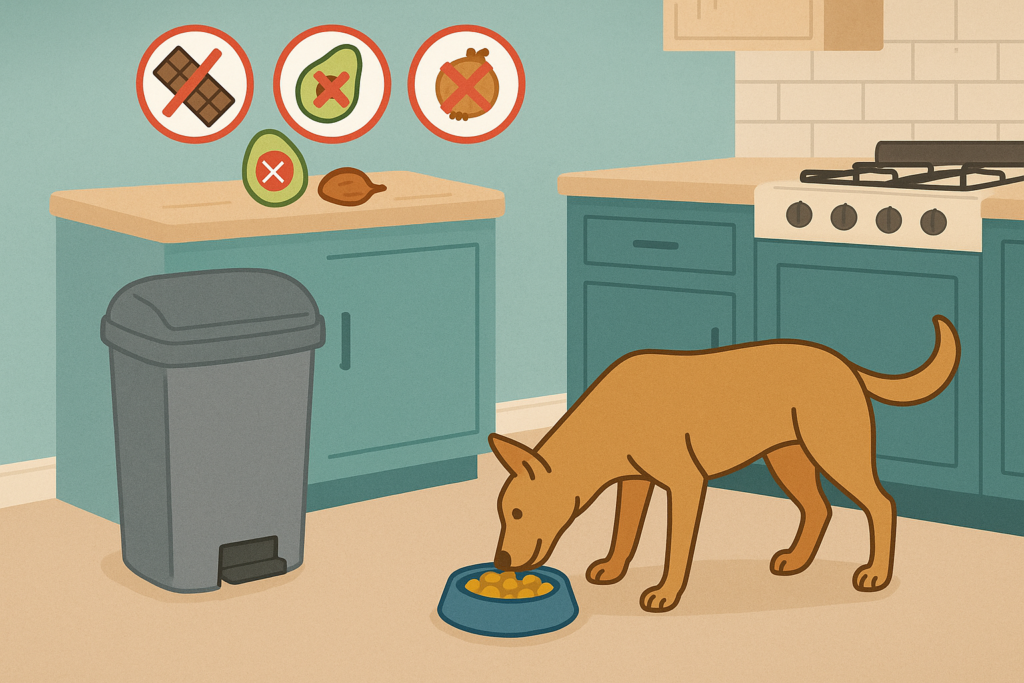
You can’t prevent every case of dog vomiting, but many are avoidable with simple habits.
1. Feed a Consistent, Balanced Diet
- Choose high-quality commercial dog food appropriate for your pet’s age and size
- Avoid frequent food switches transition slowly over 7–10 days
- Don’t feed table scraps or fatty leftovers
2. Prevent Dietary Accidents
- Use pet-proof trash bins
- Keep pantry items, chocolate, gum, and bones out of reach
- Watch your dog closely during walks to prevent scavenging
3. Slow Down Eating
Gulping food can trigger vomiting. Try:
- Slow-feeder bowls
- Puzzle feeders
- Feeding smaller meals more frequently
These work especially well for fast-eating breeds like Labs or Boxers.
4. Reduce Stress and Motion Sickness
- Use calming supplements or thunder shirts for anxious dogs
- Get your dog used to car rides gradually
- Avoid feeding right before travel
5. Keep Up with Vet Visits
- Annual checkups can catch chronic problems early
- Maintain routine deworming and vaccines
- Discuss recurring or unexplained vomiting with your vet
I’ve caught several cases of liver disease or early kidney problems just from investigating “occasional” vomiting.
FAQs About Dog Vomiting
Why does my dog vomit yellow bile in the morning?
This often points to bilious vomiting syndrome, caused by an empty stomach. Try feeding a small bedtime snack. If it happens regularly, check with your vet.
Can I give my dog water after vomiting?
Yes but in small amounts. Offer a tablespoon of water every 15–30 minutes. If vomiting continues or water triggers more vomiting, seek veterinary help.
How long should I fast my dog after vomiting?
For healthy adult dogs, 12–24 hours of no food is safe. Puppies and small breeds should not be fasted without vet advice due to the risk of low blood sugar.
When is vomiting an emergency?
If vomiting is frequent, contains blood, is paired with lethargy, diarrhea, bloating, or suspected toxin ingestion it’s an emergency. Go to the vet immediately.
Can stress cause dog vomiting?
Absolutely. Loud noises, travel, boarding, or changes in routine can all trigger dog vomiting. Reducing stress and creating a calm environment can help.
Is it okay to treat vomiting with human medicine?
No. Human meds like Pepto-Bismol or Gravol can be dangerous. Only use medications prescribed by your vet.
Conclusion
Dog vomiting is one of the most common reasons for vet visits and for good reason. While a single episode may be harmless, vomiting can also be a warning sign of something serious.
By understanding what causes vomiting, how to assess it at home, and when to call the vet, you can act confidently to protect your dog’s health.
In my experience, the earlier you respond to concerning symptoms, the better the outcome. Trust your instincts. If your dog seems “off” or you’re unsure, it’s always safer to check in with your veterinarian.
A balanced diet, safe environment, and regular checkups go a long way in preventing vomiting and keeping your pup happy and healthy.
Your dog depends on you to know when something’s wrong and now, you do.

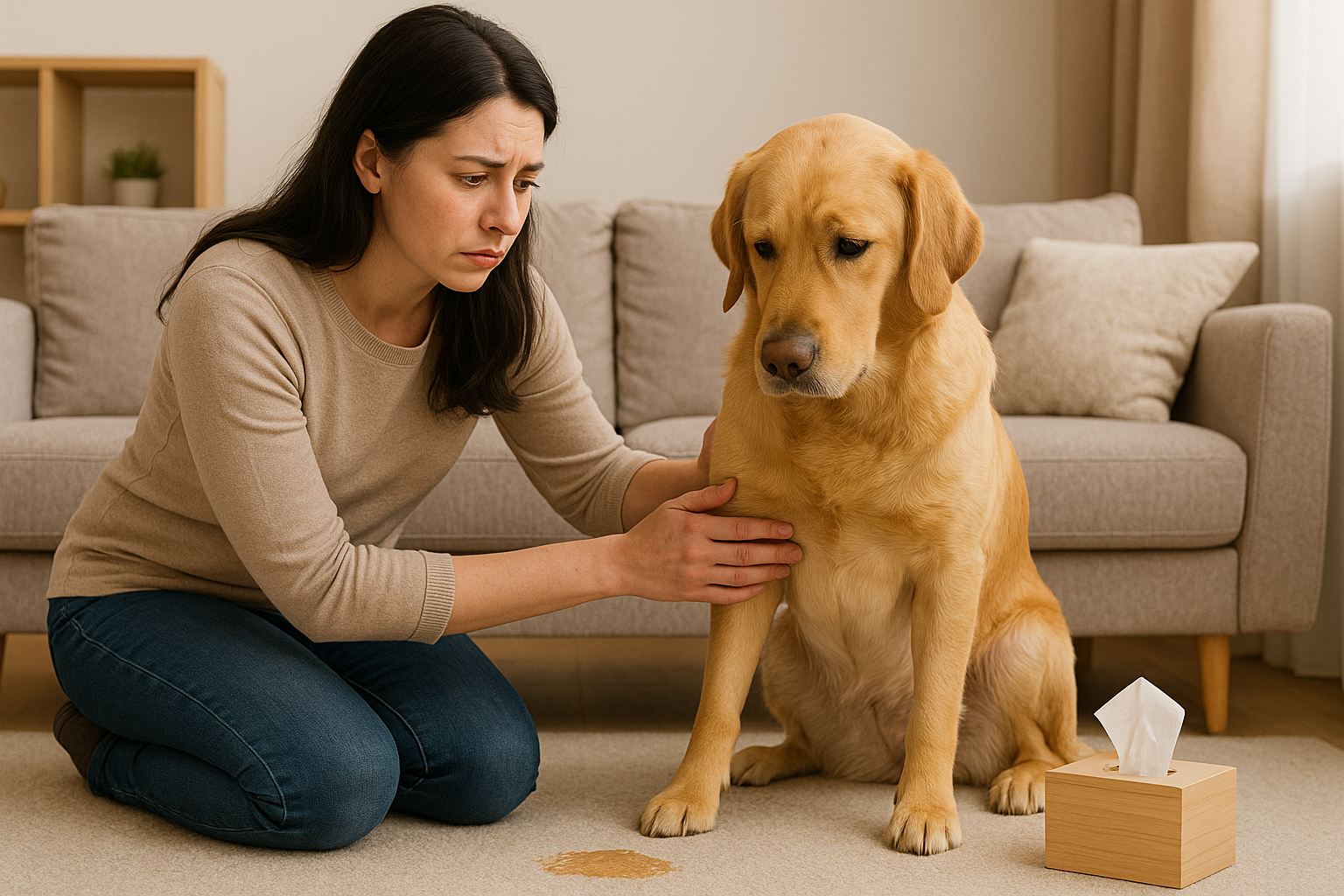



Pingback: 2025 Expert Guide: Dog Coughing Causes, Symptoms & Urgent Vet Advice
Pingback: Dog Throwing Up Yellow Foam at Night? Vet Advice & Fixes 101
Pingback: How Long Can a Sick Dog Go Without Food? 101